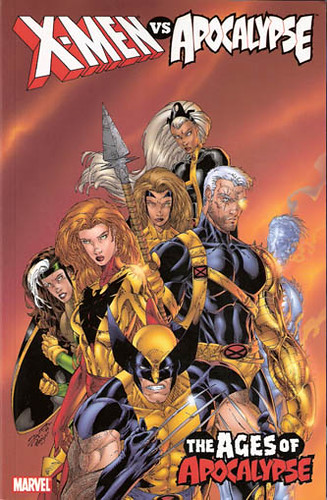X-Men vs. Apocalypse, v. 2: Ages of Apocalypse
Collects: X-51 #8, Uncanny X-Men #378, Uncanny X-Men Annual ‘99, Wolverine #148, Cable #77, X-Men #98, X-Men: The Search for Cyclops #1-4 (2000-1)
Released: September 2008 (Marvel)
Format: 288 pages / color / $29.99 / ISBN: 9780785122647
What is this?: Continuation from X-Men vs. Apocalypse, v. 1, picking up almost immediately after the previous volume leaves off.
The culprits: A predictably large crossover cast; writer Joseph Harris and artist Tom Raney get the biggest chunk of the book.
If you would have told me I would prefer X-Men vs. Apocalypse, v. 2: Ages of Apocalypse to X-Men vs. Apocalypse, v. 1, I would have called you a damn dirty liar and punched you in the face.
Well, I probably wouldn’t have punched you in the face, since the court-ordered treatments have taken care of that. (Mostly.) But I probably would have thought you had a few servomotors malfunctioning in your metaphorical power armor.
 I remember reading most of these stories when they came out, back at the turn of the century, and thought they were, for the most part, forgettable. Putting aside the idea I can remember something as forgettable, it certainly felt it was not a worthy follow up to the storyline that ended The Twelve storyline once and for all. Having actually read what was in v. 1, however, I have to reappraise v. 2.
I remember reading most of these stories when they came out, back at the turn of the century, and thought they were, for the most part, forgettable. Putting aside the idea I can remember something as forgettable, it certainly felt it was not a worthy follow up to the storyline that ended The Twelve storyline once and for all. Having actually read what was in v. 1, however, I have to reappraise v. 2.
Don’t get me wrong; the quality of the content in Ages of Apocalypse is wildly variable. X-51 #8 and Uncanny X-Men Annual ’99 have nothing to do with Apocalypse and are included because, well, they seem to fit in the chronology, even if the characters’ chronology is a distraction from the plot. Not that the plot itself is much to write home about, but I have to pay lip service to it.
In v. 1, Apocalypse didn’t gain all the power he wanted, and he usurped the wrong body; to rectify this, he makes the X-Men think they are in various alternate realities so they will expend their energies and he can harvest them. Fair enough, although the stories sort of wave their hands in the general direction of how Apocalypse actually harvests it. The alternate realities stretch from the founding of the X-Men to the far future.
The best of the stories have fun with the alternate realities. Erik Larsen and Roger Cruz tell a story of the very brief, how-Bendis-might-have-conceived-them “New” Fantastic Four that briefly formed in Fantastic Four #347-9. Larsen doesn’t worry about making the story coherent; he drops readers into an action sequence, and keeps blowing stuff up and having the Fantastic Four save the day. It is far and away the best part of the book, and parenthetically, it’s the best part of Larsen’s otherwise disappointing run on Wolverine. The rest of the stories aren’t that kinetic, but they have their highlights: Adam Kubert’s Rogue as Mastermind-in-Uncanny-X-Men #1 is very nice, and Alan Davis has fun with the far future X-Men in X-Men #98, which serves as an excellent coda to the stories.
Not all of the stories are as fun, of course; Bernard Chang’s art in Cable #77 is stiff, and the plot is nothing to write home about. The lettering in Cable bothers me, just as it did in v. 1; it’s distracting and adds nothing to the story. X-Men Unlimited #26 is eminently forgettable, as most X-Men Unlimited stories were after the first year.
Whether the book succeeds depends on the miniseries collected at the end of Ages of Apocalypse: The Search for Cyclops. It’s a serviceable return to the status quo by Joseph Harris and Tom Raney, although no one’s going to remember it in a few years. In fact, no one remembers it now. But Harris was given the order to return things to the status quo, and he manages to do it.
It’s disappointing, but it was inevitable. The story doesn’t tread any new ground, except to introduce Anais, another superpowered follower of Apocalypse. I would have rather an old henchman of Apocalypse fulfilled her role; really, to build the idea that this might be the end for Apocalypse, it would have been better to throw in more of his old allies, such as the Dark Riders, his Horsemen, or the Alliance of Evil. Instead, we get Gauntlet, a former member of the Dark Riders, acting as an assassin, and … well, that’s it. There’s three issues of Scott wondering who he really is and Jean and Cable arguing over whether they can kill the merged Cyclops and Apocalypse, followed by one issue of fighting. As I said, disappointing, but inevitable. (Well, inevitable except for the odd alternate covers for issues #2 and 3, which feature Jean and / or Scott semi-clothed despite no hint of sensual content in any part of the series. But that’s just an odd cover choice.)
As I said, I enjoyed this more than v. 1. That does not, of course, make it good. The entirety of this series is best left to the X-Men fans, perhaps as a punishment for being on top of the comic-book heap for so long.
Rating: ![]()
![]() (2 of 5)
(2 of 5)
Labels: 2, Adam Kubert, Alan Davis, Apocalypse, Bernard Chang, Cable, Cyclops, Egypt, Erik Larsen, Jean Grey, Joseph Harris, Marvel, Roger Cruz, Tom Raney, X-Men vs. Apocalypse




0 Comments:
Post a Comment
<< Home